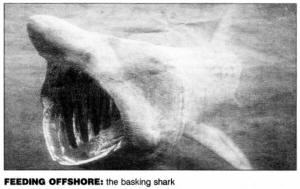
Gentle giants of the deep bask in study
by Paul Cormacain
 WE
are going to leave the land this week and take an imaginary trip
round the waters of western Europe. Most of us will have done this
on a minor scale, with folk like me first taking the ferry to
England when in my teens. Many will have travelled by water to
Scotland, others will have gone over the North Sea to Scandinavia.
Many more will have headed in a more southerly direction, travelling
from the south coast to France or Spain.
WE
are going to leave the land this week and take an imaginary trip
round the waters of western Europe. Most of us will have done this
on a minor scale, with folk like me first taking the ferry to
England when in my teens. Many will have travelled by water to
Scotland, others will have gone over the North Sea to Scandinavia.
Many more will have headed in a more southerly direction, travelling
from the south coast to France or Spain.
Others will have driven the long way across Scotland and /or England, then taken the ferry over to France. We are obviously a nation of travellers, we obviously feel at home on sea or land, indeed it could be said that we are all seafarers at heart. All the more reason to write about the sea, and one of its major inhabitants.
Now that we are all convinced that we are not landlubbers, let us look at the fate of one of the largest animals that is within swimming distance. It is the basking shark. You may well have seen this creature on your travels, and I certainly hope you see many more in future.
If so, you may well look at it in a different light.
The basking shark can grow up to 12ms in length, and can achieve a weight of seven tonnes. If you look at its teeth, well, maybe do not bother, but they are very small.
They have little to do with the eating process, for this giant feeds on tiny animal plankton only. Honest, no arms, no legs, no humans, only plankton.
Most of the summer this shark lives off the coasts of Scotland. England, Wales and Ireland. It can frequently be seen from the shore, when it feeds off shore on the surface in full view of anyone who knows or cares where and when to look from the land. As with all creatures in the wild it seems to know where and when to go to acquire a good meal. Research shows that the creature will swim thousands of kilometres for a good feed.
Sharks can now be tracked by satellite. (Nothing is private, is it?)
One beast was tracked for 1878kms, as he swam from the English Channel to the Outer Hebrides, and it took him 77 days to travel this distance. It is believed that his motivation for travel was his motivation for desire of food.
In certain areas surface slicks known as fronts appear where two bodies of water meet. Here can be found much plankton, including particularly delicious, to sharks, copepods. This would be the sharks' favourite food. In western European waters there can be many fronts. Local ones would be at the Isle of Man and the Firth of Clyde, and further afield they can be found at the western isles of Scotland and further south at the south of Ireland and south west of England.
The Wildlife Trust is particularly interested in basking sharks. Let us face it, the Wildlife Trust is particularly interested in all forms of wildlife, and thank goodness for the Wildlife Trust. The Wildlife Trust, and indeed others, would like to know more about basking sharks. To put a conservation scheme in place, you must have as much information as possible about the creatures you are trying to help, and you must involve as many folk as possible. So the trust is appealing to people who walk along the shore and sight a shark, to tell them about it. Time, date, numbers, estimate of size, weather, and anything else of apparent importance, all would be appreciated by the trust. Anglers may have more opportunities of shark sightings, and they are asked to let the trust know. Or if you are a diver, or a boat person, or a fisher person, you will likely see sharks from time to time. Please let the trust know!
It has been found very helpful to have photographs of sharks, so if you have taken a snap of one of these creatures it would be appreciated. The shape of the fm, the pigmentation, any marks or scars or injuries, all help to identify individual creatures. The more information that comes in will them help to see where the creatures are, and when, and how many there are. More than 300 sharks, at the last count, have been positively identified by photography, and future sightings help to build up a more comprehensive picture of these huge `gentle giants'.
Just in case you get your shark identification wrong, perhaps you should not get too close.
Ulster Star
02/04/2005
